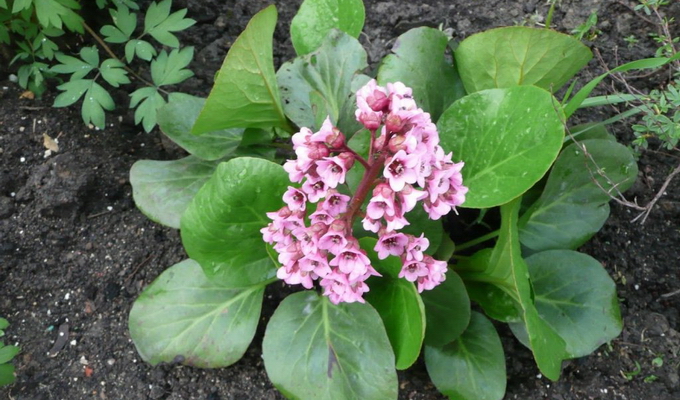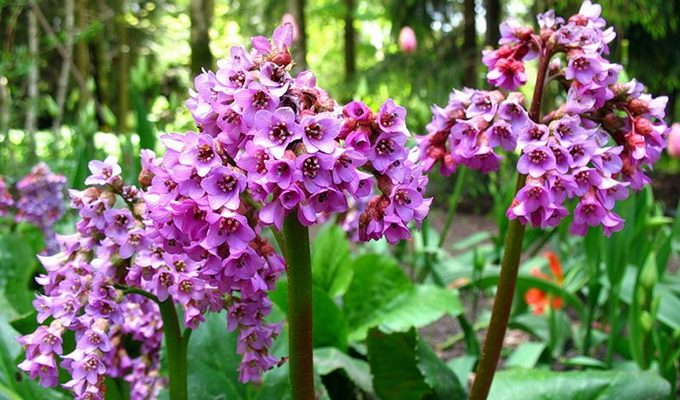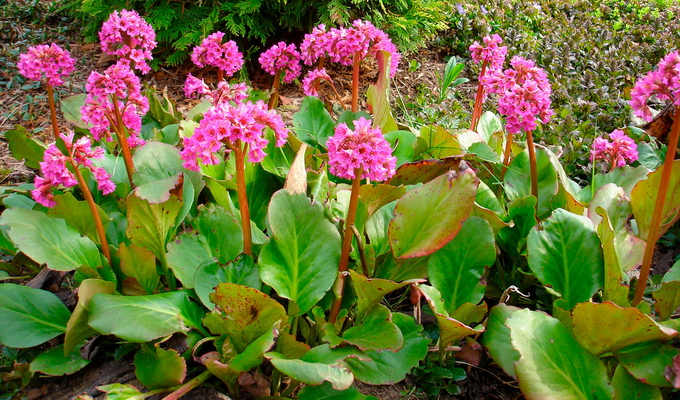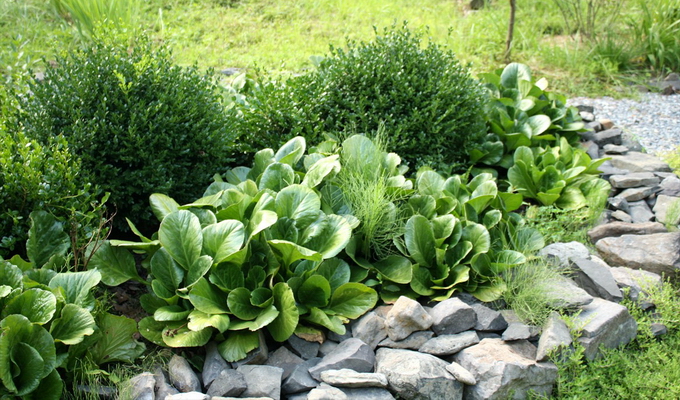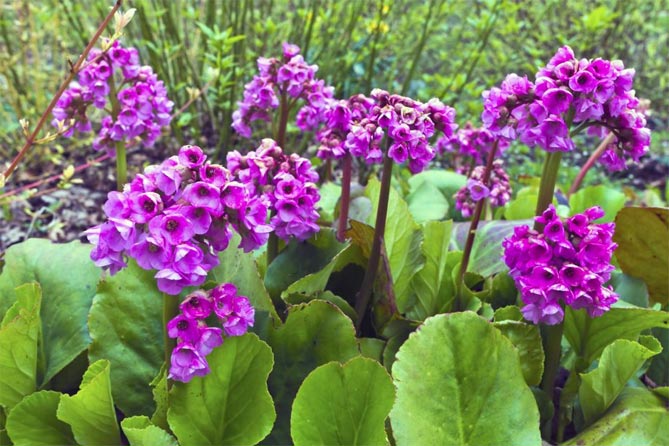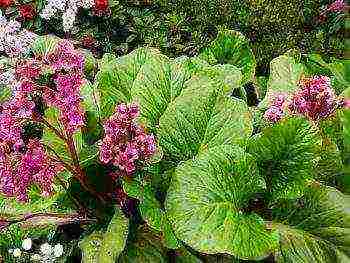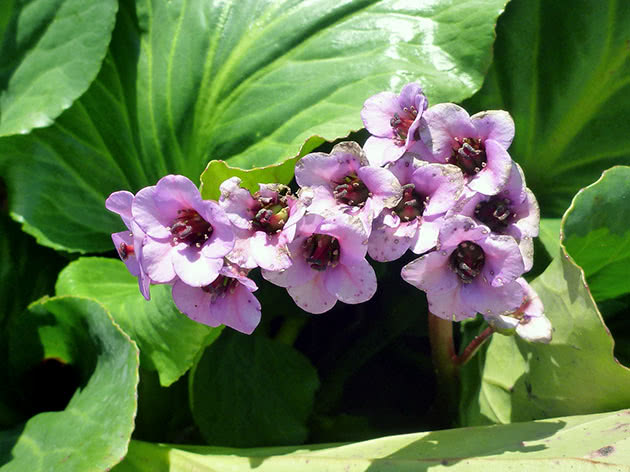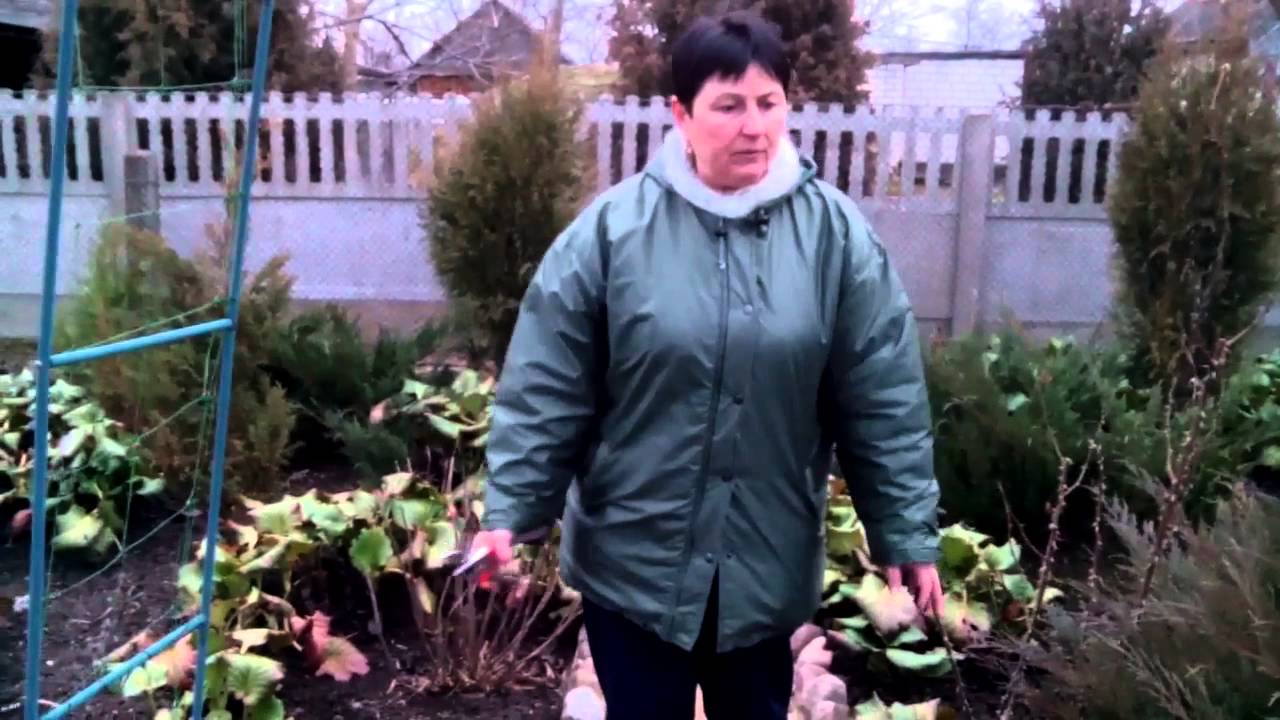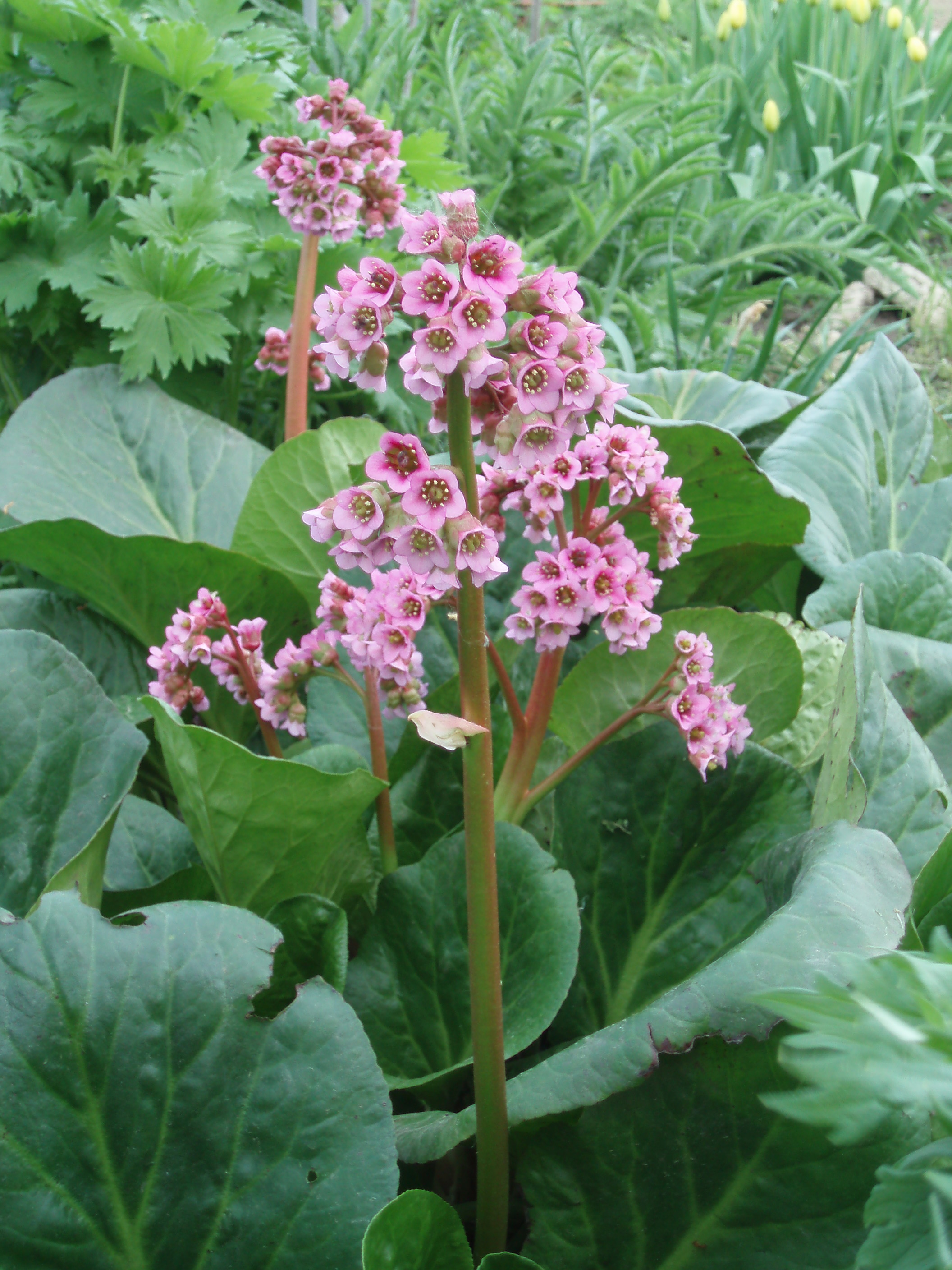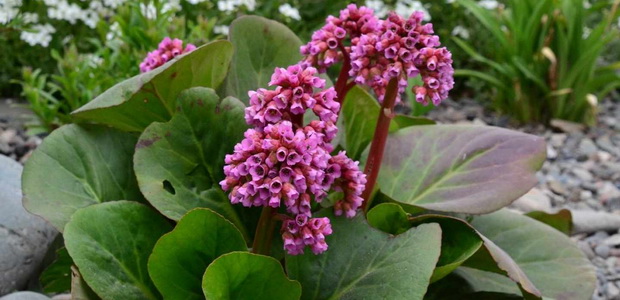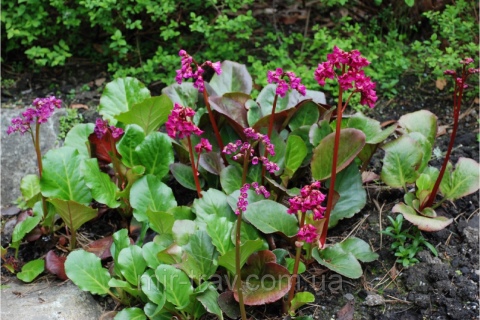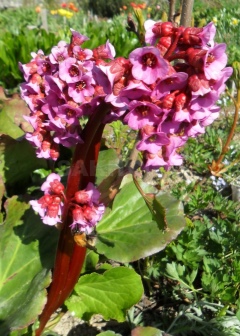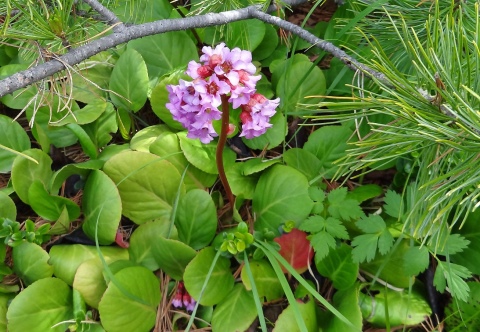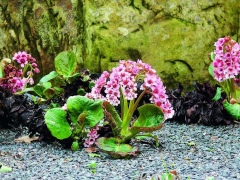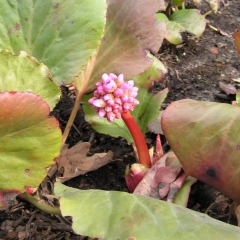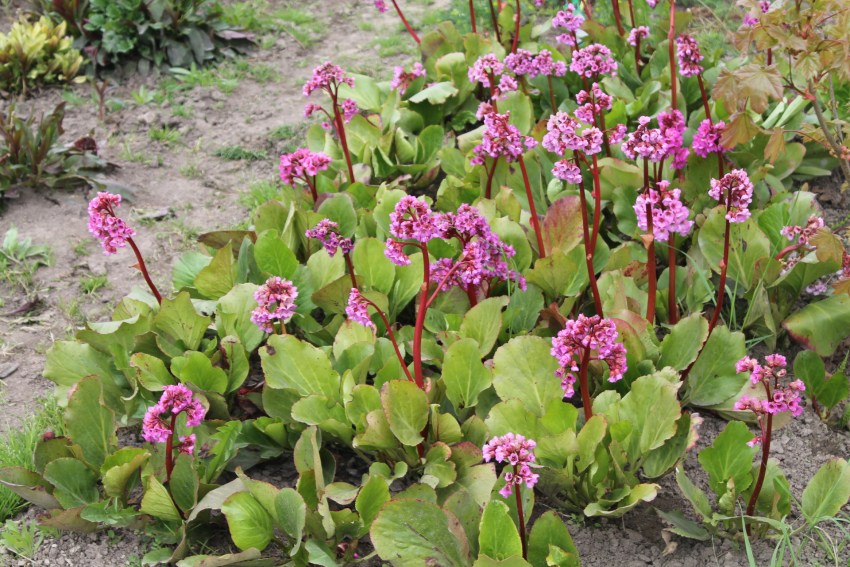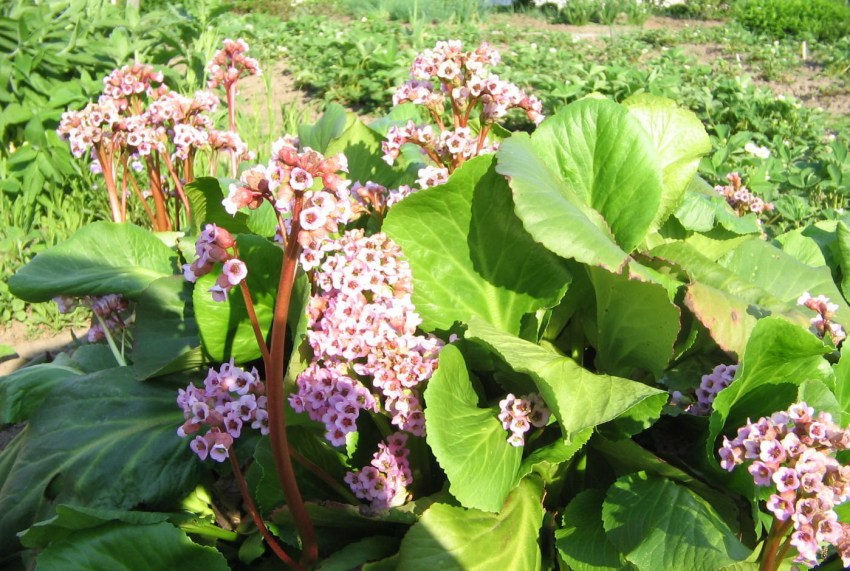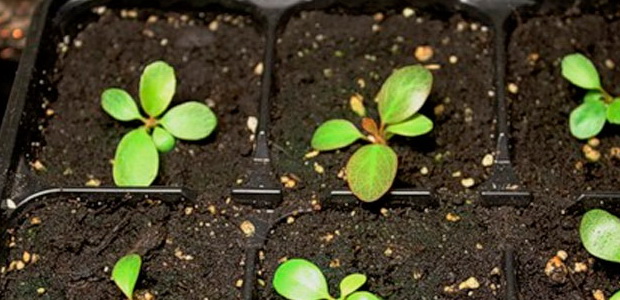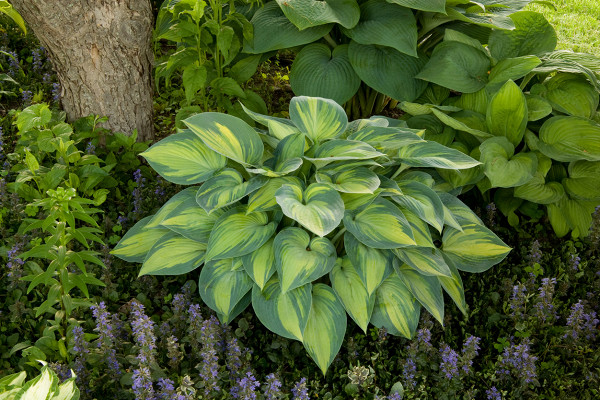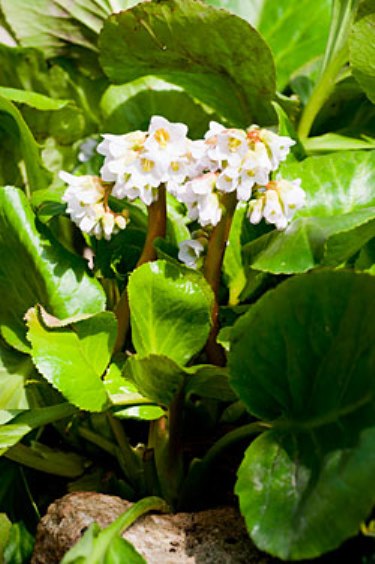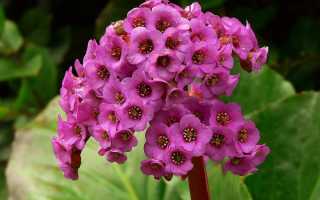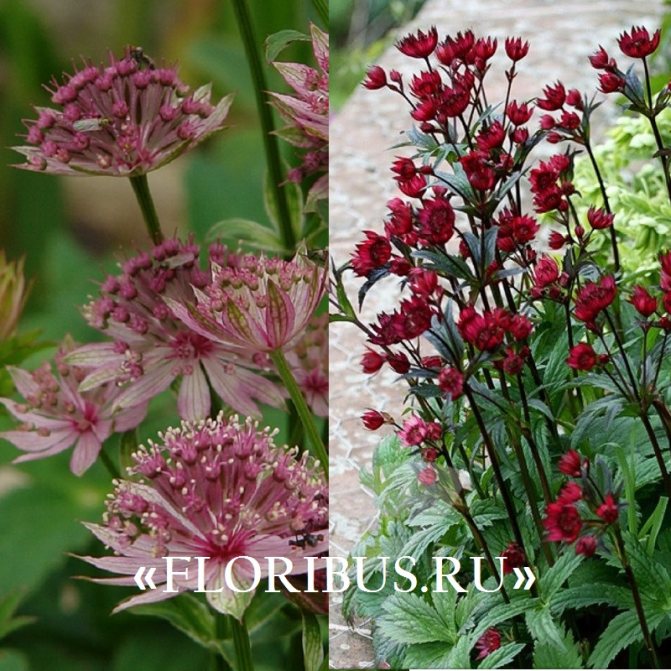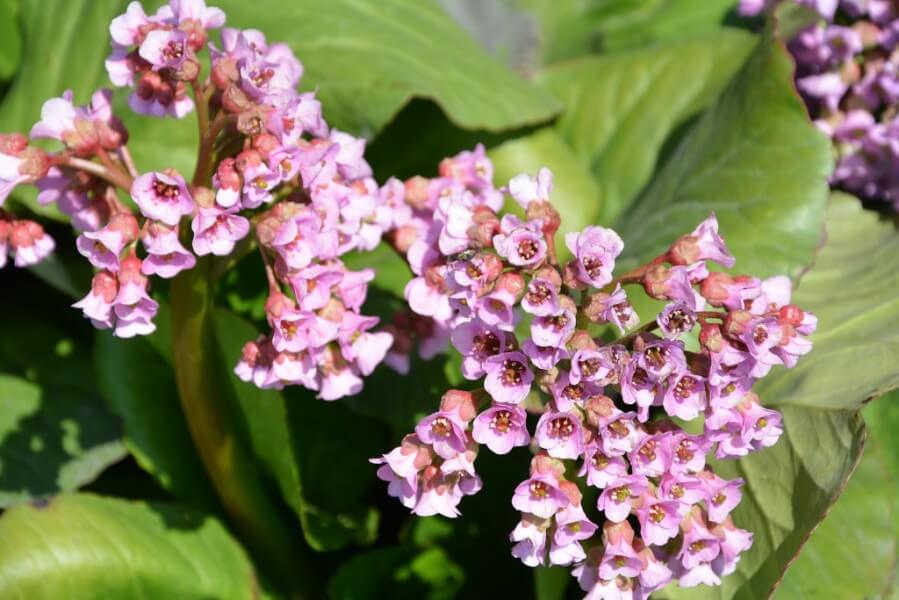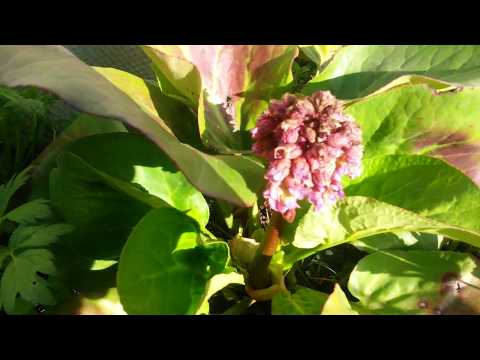Healing properties of Siberian perennial
The medicinal properties of the Siberian flower have been known for a long time. Perennial leaves and roots are a real storehouse of carotene, tannic, ascorbic and gallic acids. Decoctions and infusions of bergenia thick-leaved have a beneficial effect on the intestines (improve peristalsis and the functioning of the endocrine glands), have bactericidal and anti-inflammatory properties.
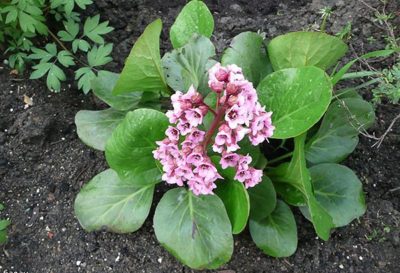
From adult leaves that have turned black during the winter, you can brew an unusually aromatic and tasty Altai tea, which remarkably strengthens the cardiovascular system. And if you brew young leaves and flowers (20 g per glass of boiling water), then the resulting broth can cure the skin from acne, seborrhea and dermatitis.
A decoction of badan is also used in gynecology. A decoction from the fleshy roots of a flower copes well with erosion of the cervix. There are also contraindications for drugs based on saxifrage. Long-term use of them can provoke constipation, lower blood pressure, increase blood clotting and speed up the heartbeat. So people with similar problems should abandon the use of such decoctions or limit their consumption to a minimum.
Badan is a unique healer
Once, while visiting, I had a chance to taste aromatic tea with a tart, slightly tarry aftertaste. It turned out to be tea made from last year's badan leaves. Yes, don't be surprised! - it is the wrinkled dried leaves, which we ruthlessly brush away from the beds in the spring, and served as the basis for medicinal tea.
It is called Chigir tea in Altai, the birthplace of badan, and in Siberia it is called Mongolian. During wintering under the snow, the leaves undergo natural fermentation and become unusually healing. Chigir tea tones up, improves immunity, and treats many diseases. A dozen years ago, in many markets there were whole rows where they sold dried berry leaves. By the way, green leaves are not suitable for tea leaves, but they say that they can be used for making stuffed cabbage rolls. I don’t know, I didn’t carry out such experiments, but in this picture the berry leaves are very similar to cabbage leaves.
So, having tasted delicious tea and learned about its healing properties, I decided to make a separate bed at my dacha specifically for planting badan. Fortunately, it is unpretentious and suppresses all the weeds around. And after winter, I collect the overwintered leaves, wash them thoroughly, dry them and put them in canvas bags. And my whole family enjoys drinking a fragrant and healing drink. In addition, medicinal decoctions and ointments are prepared from the rhizomes of badan, but this is a topic for a separate article.
Badan is an evergreen perennial of the saxifrage family, which is not only medicinal, but also decorative. Badan is also called bergenia (lat. Bergenia) in honor of the German doctor and botanist Karl Bergen.
Badan is famous for its bright inflorescences of small goblet flowers located on leafless peduncles. In one inflorescence there are up to 120 flowers up to 2 cm in diameter each. And its large shiny leaves, collected in a basal rosette, resemble the shape of an elephant's ears. Therefore, it is often called "elephant ears". Badan brings a kind of "zest" to the architecture of the garden. In landscape design, it is indispensable in compositions with narrow-leaved and variegated plants: with hosts, arabis, phlox. Looks very impressive against the background of water and stones.
In nature, there are 10 species of badan, of which many varieties are cultivated for garden cultivation.I planted thick-leaved incense, because it is from its leaves that the healing Chigir tea is brewed. I chose a place in partial shade, not far from a grove of fruit trees. Badan does not tolerate open sunny places - in such conditions, its development slows down.
The unique healer loves loose, light, slightly alkaline and moist soils, because it has a weak root system. Its thick horizontal roots are located very close to the surface, therefore, both the drying of the soil and its waterlogging should not be allowed. Indeed, in its natural habitat, the roots are protected by dead leaves, which naturally mulch the earth, retaining moisture in dry months and protecting the soil from waterlogging during the rainy season. In gardens, for aesthetic reasons, we remove old leaves (or collect them as a medicine), and the roots are left without natural protection.
However, bergenia grows so strongly that several of its sprouts, planted side by side, completely cover the soil 2-3 years after planting. Many silky evergreen leaves grow from small adventitious roots of the mother rhizome. So weeding does not threaten you in beds with bergenia, with its intensive growth it clogs all the weeds.
It is interesting to observe how, in early spring, thick stalks of dark green "elephant ears" of badan get out of the snow, growing up literally before our eyes. And already at the end of April or at the beginning of May, it begins to bloom and pleases the eye with the grace of the inflorescences until the end of June. Its fragrant pink, purple, white or bright red flowers, collected in panicles and covered with a light waxy coating, rise like rainbow splashes above the lush rosettes of ornamental leaves. And in the fall, the leaves acquire a bright bronze or lilac-brown hue, which lasts until spring. Sometimes badan gives summer residents a pleasant surprise - it blooms again in August or September.
Popular species and varieties
Badan has 10 species with many varieties that differ in size, color and leaf shape. Flowering is also different in terms of timing and effectiveness - there are forms with double and semi-double flowers of original colors.
Heart-leaved badan is the most popular species, native to Altai. The plant is undersized, no more than 40 cm in height, with thick, dark green, heart-shaped leaves. Bell-shaped flowers of white, pink, lilac and lilac colors. Flowering begins in May and lasts 20 days. It is a very frost-resistant species - the leaves overwintering under the snow can withstand temperatures as low as -40 ° C.
One of the most frost-hardy species is heart-leaved berry
Badan thick-leaved is found in Altai, Sayan and Mongolia. An evergreen herb grows up to 60 cm in height. Glossy leathery leaves of a rounded shape are collected in a dense rosette. The paniculate inflorescence consists of numerous bell flowers of a delicate pink or lilac color. Badan thick-leaved is distinguished by early flowering - from the end of April to June. The decorative effect is preserved throughout the summer thanks to the succulent leaves, some of which turn red by autumn, enhancing the showiness of the plant. Winter-hardy view - the foliage does not change color under the snow and the plant meets the spring with green and purple colors.

Badan thick-leaved - a large plant with shiny leaves and luxurious flowers
The Galina Serova variety is attractive due to the variegated color of the leaves and for the same reason prefers a sunny location. The large leathery berry leaves with white strokes are charming throughout the summer, and in the fall, when the green color changes to red, a fireworks effect is created in the garden. It blooms in May-June with bell-shaped pink flowers. Winters well under the snow.

Galina Serova is a rare variety of badan, characterized by variegated leaf color
In Europe, Schmidt's badan is most popular.Differs from other varieties with matte large leaves and the presence of a kind of "wings" growing from the center of the rosette. Bright pink flowers are collected in a spherical inflorescence on a low peduncle. The plant is winter-hardy, unpretentious, blooms in May-June, but retains its decorative effect throughout the summer.

Rose balls-inflorescences of Badan Schmidt fell in love with European gardeners
Badan Bressingham White is a hybrid, shade-tolerant variety that prefers wet places, but does not impose special requirements on the composition of the soil. Large, dark green glossy leaves form a rosette 30 cm high. White flowers are collected in loose inflorescences. Blooms in May – June. Frost-resistant variety.

Bressingham White is a hybrid grape variety with spectacular white flowers
Badan Abenglut is a shade-tolerant, unpretentious, frost-resistant variety. Planting in sunny places withstands, but does not grow magnificently, besides, in bright light, the flowering period is shortened. Bright green leaves, collected in a low rosette, acquire a beautiful bronze tint in autumn. Purple semi-double flowers on thick red peduncles delight the eye from April to May.

Badan Abenglut attracts attention with bright semi-double flowers
Seat selection and landing
Badan can be planted in a wide variety of areas: in the shade and in open sunny places, on the banks of reservoirs and warmed up warm slopes. However, places located in light partial shade are best suited for a perennial. Plants may stop blooming in full shade.

Badan can be grown in different areas
The choice of location for this perennial plant should depend on the result you want to get. If berry is planted in partial shade, where moisture remains in the soil for a longer time, it will grow in a thick and juicy green carpet, but it will bloom quite modestly.
In areas warmed by the sun, the plant will delight you with lush flowering, but it will not be able to form powerful bushes with dense foliage and will have a somewhat depressed appearance. Badan growing in the sun requires regular watering.
Low-lying areas where water stagnates or groundwater is close to bed is completely unsuitable for growing badan. In this case, the roots of the plant can rot. Berry will grow best on light, fertile and moderately moist soils, neutral to slightly alkaline.
For planting seedlings and badan plots, shallow holes are made, on the bottom of which a little coarse river sand is poured for drainage. The plants are transferred together with a lump of earth and covered with soil. Watering must be done after planting.
Since badan grows well in the wild on poor rocky soils, you can try to make a similar soil in your area. To do this, usually mix 2 parts of sand, 2 parts of small stones and 1 part of sod land. Small amounts of gravel and sand can also be added to loamy soils.
Planting and leaving
Badan is an unpretentious perennial plant that easily tolerates low temperatures. The flower feels most comfortable in shaded areas with a moderate amount of sunlight, which are protected from strong drafts. Direct sunlight negatively affects the plant and can lead to a slowdown in its growth and the appearance of yellow spots on the leaf plates.
Novice gardeners should pay attention to the fact that plants grown in full shade will not be able to form inflorescences and will not please with bright and beautiful buds.
The most favorable time for planting badan is late summer and early autumn. The flower prefers to grow in flower beds with light and fertile soil, but it is better to avoid wetlands. Excessive moisture can provoke rotting of the root system and the death of the plant. The optimum distance between plants is 35 cm.
To root the seedlings, it is necessary to form a planting hole that exceeds the diameter of the flower's root system. To prevent root decay, it is imperative to cover the bottom of the hole with drainage material, which can be expanded clay or broken brick. It is necessary to fill the planting hole with soil consisting of equal parts of earth, gravel and river sand. Planted flowers should be watered abundantly with clean and settled water.
Badan has a negative attitude towards frequent transplants and can grow in one place for at least 10 years
To ensure the most comfortable conditions for the growth and development of a flower, experienced gardeners recommend paying special attention to caring for it. This process consists of a set of standard procedures, which include watering and pruning the plant, enriching the soil with nutrients, loosening the soil and protecting the flower from parasites and diseases.
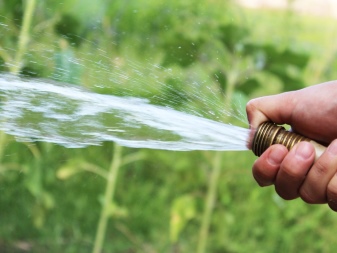

After planting a flower, it is imperative to mulch the entire root zone. This event will prevent the soil from drying out and will allow less frequent watering of green spaces. The plant does not need a lot of water, but it is necessary to moisten the soil regularly and in small portions. To maximize the supply of flowers with oxygen, it is necessary to regularly weed the area with the simultaneous removal of weeds, which take not only moisture from the soil, but also micronutrients.
At the end of autumn, experts recommend cutting off the entire above-ground green part, and in regions with unfavorable climatic conditions, cover the bushes with non-woven material or spruce branches. In the spring, it is imperative to carry out sanitary pruning of green spaces, which will help to give the bushes a well-groomed appearance.
Badan: planting and care
Many gardeners say that thick-leaved incense is one of the most unproblematic plants in terms of planting and caring for it. This feature and the fact that badan is quite "photogenic" often becomes the reason for breeding a whole collection of badans. However, after observing the life of this plant, experienced gardeners understand that berry planting and care keeps many secrets.
First, when acquiring a cut (that is, part of a stem or bush with roots), make sure that it is healthy. If it is rotten or rotten, it is unlikely that it will be possible to save the plant even with the help of modern methods.
Secondly, for good growth and longevity of the plant, it is necessary to choose the right place for planting it. Since badan has been blooming for more than one year, it has to winter for a long time, especially in the climate of our middle zone. This test will not be painful for the plant if it is covered with a thick layer of fallen leaves all winter, which will prevent the snow from freezing the plant. Otherwise, with the arrival of spring, the berry will spend more time recovering from the cold than on active flowering. If the plant is in unfavorable conditions for several winters in a row, it faces inevitable death.
Considering the above, we can conclude that the optimal place for badan is a near-stem section of large trees in its southern part. A warm cover of fallen leaves of badanu is provided, and the surface rhizomes, which will be located between the roots of the tree, will not get wet: the tree itself will take away excess moisture from the roots.
Badan landing has other subtleties. In order for the plant to grow quickly in spring, it is better to plant it at an angle so that the cuttings take root. Already in the first fertile seasons, many vegetative buds will be born, which will give new material for planting. You can plant bergamo and vertically, but then do not expect early offspring.
Sometimes, for the effective growth of bergenia, a buried planting method is used. In this case, the plant can grow in breadth, but you will need to carefully monitor so that decay does not appear.
Badan does not require abundant watering, therefore, even in extreme heat, the ground under a fresh plant should be soaked only until the earth subsides and the voids at the roots of the badan are filled.
In the matter of breeding a plant such as incense, planting and care are very important. This is especially true of the second point. We suggest you take advantage of the recommendations of experienced gardeners who have already gotten a handle on caring for badan:
- In spring, you should not remove fallen leaves from the ground and shake them off the plant itself, because they are both a decoration for your garden and an effective shelter for a plant that can save it in unexpected frosts.
- In the spring-winter period, the plant acquires a magnificent color: the leaves become multi-colored (mainly shades of red, as well as brown and even purple), covered with patterns and borders. But this property manifests itself not only as gratitude to the mistress for proper care, but also as a signal that it does not need to be fed, the plant uses the necessary substances accumulated since last season.
- You should start feeding the berry when the leaves acquire an even green tint. Top dressing is recommended to be applied in small portions, three to four times in one season.
- It is advisable to transplant and divide plants 2-3 weeks after flowering. During this period, the foliage of the plant becomes softer, the shape of the bush itself softens and a long process of growth of young leaves and buds begins. In September - October it will be too late to transplant and cut the berry.
- An ideal part of the plant for transplanting is a rosette of leaves with a part of the rhizome.
- If you are going to translate the cut, then you can save it by sticking wet moss on the rhizome and placing the sprout in a plastic bag.
- If in badan you are more attracted by lush flowering, then you should choose a sufficiently illuminated and heated area in the garden, and if spectacular red foliage, then in the shade.
- The appearance of warm colors on the leaves of badan is a signal to stop transferring and dividing manipulations.
- Do not be alarmed if the next year after abundant flowering, the berry does not want to please you with flowers at all. You can avoid this by deliberately overdrying the berry bushes in the middle of summer. In special cases (heavy rains in early summer and drought at the end), badan, on the contrary, can bloom again.
Application recipes
Badan medicines are prepared in various ways. It can be an extract, a decoction, as well as an alcoholic or aqueous tincture of roots and leaves. It all depends on the scope of use of the herbal remedy and the desired concentration of the active substances of badan in it.
Badan tea
A tea drink based on badan perfectly relieves fatigue, quenches thirst, normalizes blood pressure, strengthens the body and has a number of other positive qualities. At the same time, it is quite simple to prepare.
You need to take 1 teaspoon of dry deciduous raw materials, pour 500 grams of boiling water over it, cover and leave to infuse for 10 minutes. Then you should drain the liquid, if desired, adding honey and lemon to improve the taste and increase the beneficial effect.

You can pour phyto-raw materials with cold water and bring to a boil, then the drink will turn out to be more aromatic and saturated, and the concentration of nutrients in it will be significantly higher.
It is also good to brew mixed teas, adding tea, oregano, mint or lemon balm to the Ivan badan. The choice of herbal ingredients depends on the desired effect of the drink.
For tea, green, incompletely ripe leaves should not be used. Such a drink will not only not be beneficial, but will also have a negative effect on the body. Only the lower ones are used, which have begun to dry out and have acquired a brownish tint.
Decoction
A decoction of badan perfectly removes inflammation of the bladder, as well as stomatitis and all kinds of inflammation in the mouth and throat. This remedy is taken orally or used externally.The badan broth is prepared very easily and quickly.
Take 1 tablespoon of dry leaves and roots (in crushed form), pour 250-300 grams of boiling water, and keep in a water bath for a quarter of an hour. Then the liquid should be drained and taken cold. As a rule, they drink a decoction of 1 tablespoon three times a day after meals. The same liquid is used to wipe the skin with acne or oily seborrhea. It is also used for gargling. If you need to use a decoction for baths, then the resulting 250 grams are diluted with 2 liters of water. For douching, you can use the medicine undiluted.

A decoction, prepared exclusively from the root of this plant, relieves the symptoms of colds and flu well, and also treats respiratory diseases. It is prepared as follows: 1 tablespoon of dry, crushed roots is poured with 1 glass of boiling water and lasts 25 minutes in a water bath. Stir the medicine periodically. After removing from the heat, the liquid is infused, then drained, after cooling it is ready to receive. You need to pour the broth into a glass and add boiled water to make 250 grams. Should be taken 1-2 tablespoons before meals, three times a day.
Extract

The extract is taken 25-30 drops three times a day.
For external use, 1 tablespoon of the extract is diluted in 1 liter of boiled water.
Badan infusion
An infusion of badan is taken to get rid of high blood pressure, rheumatism, and also to treat disorders of the gastrointestinal tract. It is prepared from 1 tablespoon of dry, crushed roots and 200 grams of boiling water. The phyto-raw materials filled with liquid must be wrapped or placed in a thermos, infused for 1 hour. Then the infusion is filtered and taken 1 tablespoon 3-4 times a day.
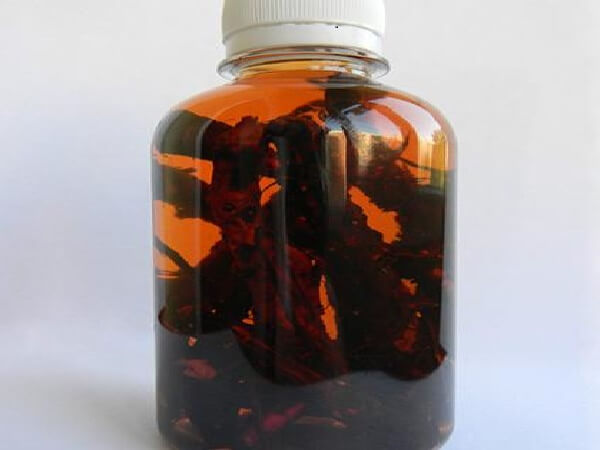
Alcohol tincture of badan is used mainly for cosmetic purposes. Making a home remedy isn't difficult. To do this, take 1 tablespoon of dry roots and pour it with 500 grams of alcohol. Having closed the vessel, it should be left warm for 6 days, and then drained.
Planting badan in open ground
Before planting a berry in your garden, one feature of the plant should be taken into account - it does not tolerate transplanting very well, so you need to think over its placement in advance so as not to move the bush in the future.
It is also desirable to create conditions for the culture that are as close to natural as possible. In other words, choose an area with a suitable soil type and lighting mode.
Illumination
Badan is a very hardy plant, and it grows successfully both in well-lit areas and in the shade or partial shade. That is why you can use it to create original flower arrangements with shade-loving hosts.
The best place for placement would be a site with rocky soil, and it is better to plant seedlings from the north, north-east or north-west side.
Soil moisture
The structure and moisture content of the soil also plays an important role in the successful cultivation of the flower. Sod soil should be given preference, but if there is none on your site, you can use a mixture of loam with compost and sand.
Soil moisture is also an important condition. The culture does not tolerate stagnant moisture, therefore, it is imperative to equip drainage on the site. When the landing site is selected and properly prepared, you can proceed directly to disembarkation.
Landing dates
Badan belongs to unpretentious crops and has high winter hardiness, but in order for the plants to take root faster in the ground, planting dates should be observed.
The best time for planting seedlings is the beginning of August, but if you grow seedlings yourself and do not want to dive, you can plant the strongest shoots in early June, and grow the rest and transfer to the ground in August
Planting badan
The peculiarity of badan is not only in its winter hardiness, but also in the special structure of the root system.It is located horizontally and is weak, so it is better to plant loose, moist and slightly alkaline soil.
In addition, it should be borne in mind that the roots often protrude above the surface of the soil, so planting should be carried out in a semi-shaded area, where the roots will not overheat and dry out (Figure 2).
Planting badan is carried out as follows:
- In the selected and previously prepared area, holes are made with a depth of no more than 8 cm.
- It is advisable to arrange the pits in a checkerboard pattern, placing them at a distance of 40 cm from each other.
- A handful of sand is poured onto the bottom of each hole, which will act as drainage.
- Next, a seedling is placed in the hole along with an earthen clod and sprinkled with soil.
 Figure 2. The main stages of planting in open ground
Figure 2. The main stages of planting in open ground
After that, the seedlings need to be watered, but even after planting, it should be borne in mind that the plant develops very slowly, and with proper care, it will bloom no earlier than 3-4 years later.

